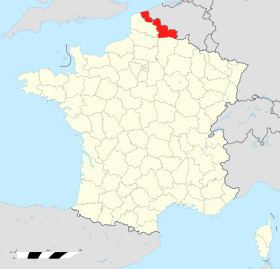Time zone CET (UTC+1) Arrondissements 6 | Department number 59 Area 5,743 km² | |
 | ||
Subprefectures Avesnes-sur-HelpeCambraiDouaiDunkirkValenciennes Population 2.596 million (1 Jan 2013) Colleges and Universities Lille University of Scienc, Lille 2 University of Health, Charles de Gaulle University, University of Valencie, Lille Catholic University Points of interest Palais des Beaux‑Arts de Lille, Villa Cavrois, Lille Cathedral, Matisse Museum, Hospice Comtesse Museum | ||
Nord ([nɔʁ]; English: North; Dutch: Noorderdepartement) is a department in the far north of France. It was created from the western halves of the historical counties of Flanders and Hainaut, and the Bishopric of Cambrai. The modern coat of arms was inherited from the County of Flanders.
Contents
Map of Nord, France
Nord is the country's most populous department. It also contains the metropolitan region of Lille, the fifth-largest urban area in France after Paris, Lyon, Marseille, and Toulouse. Within the department is located the part of France where the French Flemish dialect of Dutch is still spoken (along with French) as a native language.
History
Nord was one of the original 83 departments that were created during the French Revolution on 4 March 1790. It was made up of three regions: parts of the Counties of Flanders and Hainaut, and the Bishopric of Cambrai, which were ceded to France in successive treaties (1659, 1668, and 1678).
During the 4th and 5th centuries, the Roman practice of coopting Germanic tribes to provide military and defense services along the route from Boulogne to Cologne created a Germanic-Romance linguistic border in the region that persisted until the 8th century. Saxon colonization into the region from the 5th to the 8th centuries likely extended the linguistic border somewhat south so that by the 9th century most inhabitants north of Lille spoke a dialect of Old Dutch, while the inhabitants to the south spoke a variety of Romance dialects.
This linguistic border is still evident today in the place names of the region. After the 9th century, the linguistic border began to shift north and east, a process accelerated by modern government policies that recognize French as the country's official language. There are currently 20,000 speakers of a subset of the Dutch dialect West Flemish in the arrondissement of Dunkirk and this particular subset is in danger of extinction within decades.
Geography
Nord is part of the current Hauts-de-France region and is surrounded by the French departments of Pas-de-Calais and Aisne, as well as by Belgium and the North Sea.
Situated in the north of the country along the western half of the Belgian frontier, the department is unusually long and narrow. Its principal city is Lille, which with nearby Roubaix, Tourcoing and Villeneuve d'Ascq constitutes the center of a cluster of industrial and former mining towns totalling slightly over a million inhabitants. Other important cities are Valenciennes, Douai, and Dunkirk. The principal rivers are the following: Yser, Lys, Escaut, Scarpe, Sambre
Demographics
Nord is the most heavily populated department, with a population of 2,617,939 and an area of 5,743 km².
Politics
The President of the Departmental Council is the unaffiliated right-winger Jean-René Lecerf.
The first President of the Fifth Republic, General Charles de Gaulle, was born in Lille in the department on 22 November 1890.
Economy
At the forefront of France's 19th century industrialisation, the area suffered severely during World War I and now faces the economic, social and environmental problems associated with the decline of coal mining with its neighbours following the earlier decline of the Lille-Roubaix textile industry.
Until recently, the department was dominated economically by coal mining, which extended through the heart of the department from neighbouring Artois into central Belgium.
